Seafish’s Aquaculture Profiles Highlights BAP, Other Certification Programs
Best Aquaculture Practices (BAP) is among the third-party aquaculture certification programs referenced in a new web tool developed by the United Kingdom’s Sea Fish Industry Authority (Seafish) to guide anyone sourcing seafood, whether in the United Kingdom or abroad.
 Launched early this year, Seafish’s Aquaculture Profiles are designed to be objective and non-bias. It currently features nine finfish and shellfish species, with in-depth information on farm siting, human nutrition, animal feed, animal disease management, introduction of non-native species and certification. BAP is among the seven aquaculture certification programs listed in the web tool, and one of only two programs that addresses all eight areas of responsible aquaculture listed by Seafish, including being GSSI (Global Sustainable Seafood Initiative) benchmarked.
Launched early this year, Seafish’s Aquaculture Profiles are designed to be objective and non-bias. It currently features nine finfish and shellfish species, with in-depth information on farm siting, human nutrition, animal feed, animal disease management, introduction of non-native species and certification. BAP is among the seven aquaculture certification programs listed in the web tool, and one of only two programs that addresses all eight areas of responsible aquaculture listed by Seafish, including being GSSI (Global Sustainable Seafood Initiative) benchmarked.
“This is a brilliant example of Seafish helping to educate and inform all those involved in the purchasing and consumption of farmed seafood. It is an excellent resource which helps to simplify the complexities of farmed seafood and dispel the misinformation surrounding aquaculture,” said Mike Berthet, BAP’s market development manager for Europe.
In late June, BAP caught up with Lee Cocker, Seafish’s aquaculture manager, for a behind-the-scenes look at the origins and intentions of the Aquaculture Profiles web tool.
Why did Seafish develop the Aquaculture Profiles web tool?
Aquaculture is the fastest growing food supply sector in the world and now accounts for half of all seafood for human consumption. It is also recognized as one of the most efficient ways to produce protein. Often the source of species such as Atlantic salmon, sea bass or warm water prawns available to UK seafood buyers is from aquaculture. Those sourcing farmed seafood often have to look hard to find balanced and up-to-date information. We believe this can impact purchasing decisions when retailers or wholesalers are deciding on which farmed seafood products to stock. Our hope is the profiles will help everyone make informed decisions and dispel some of the common myths about farmed seafood.
Who’s the audience?
The Aquaculture Profiles web tool has been developed to be relevant to a wide range of stakeholders, user friendly and easy to update. This online tool is a detailed educational resource, providing open access to fully referenced information. The main audiences are seafood buyers, especially those new to the industry; responsible sourcing policymakers; students and young professionals; academia; NGOs; standard setters; legislators; media; and consumers.
Information on third-party certification program like BAP is included in each species’ profile. Why is it important to include that type of information?
There are some commonalities which all aquaculture facilities and production models share, which ensure responsible practices and potential impacts are minimized. There are a number of initiatives that promote best practices as well as independent third-party certification schemes. Production of certified seafood, both aquaculture and wild-catch, has grown rapidly over the past decade and now represents a significant portion of global seafood production. UK initiatives such as the Sustainable Seafood Coalition (SSC), which is a partnership of UK businesses, have been working to ensure all fish and seafood sold in the UK comes from sustainable sources. Aquaculture certification plays a pivotal role.
How has the response been so far?
Overall, our Aquaculture Profiles web tool has been met with extremely positive feedback and there is interest from other external projects to link to it.




